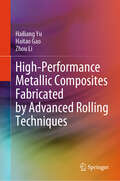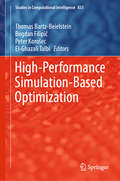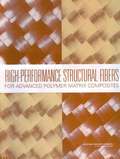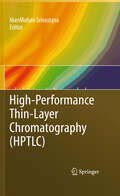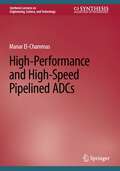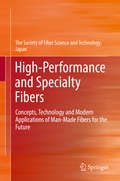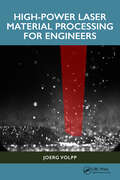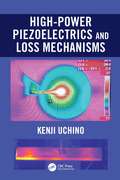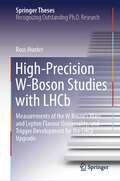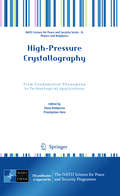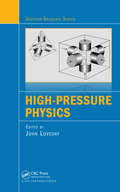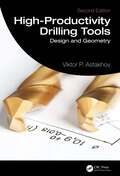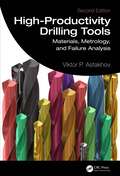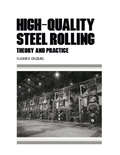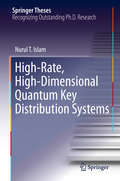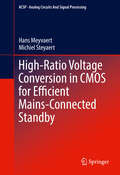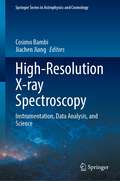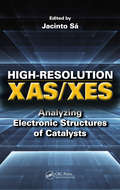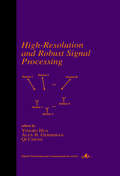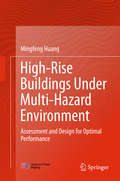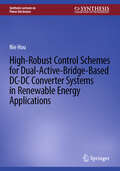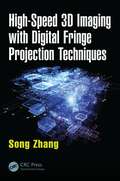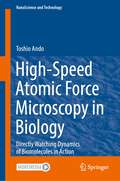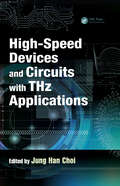- Table View
- List View
High-Performance Metallic Composites Fabricated by Advanced Rolling Techniques
by Zhou Li Hailiang Yu Haitao GaoThis book summarizes recent efforts and advances in the roll bonding of metal laminates to reveal the potential mechanism. Based on the comprehensive understanding and our numerous original works, some important issues about the fabrication method, evolution mechanism of bonding interface and reinforcement factors of roll-bonded metal laminates are discussed and emphasized. Furthermore, some prospective viewpoints about the design, fabrication and fracture mechanism of roll-bonded metal laminates are proposed.
High-Performance Simulation-Based Optimization (Studies in Computational Intelligence #833)
by El-Ghazali Talbi Peter Korošec Thomas Bartz-Beielstein Bogdan FilipičThis book presents the state of the art in designing high-performance algorithms that combine simulation and optimization in order to solve complex optimization problems in science and industry, problems that involve time-consuming simulations and expensive multi-objective function evaluations. As traditional optimization approaches are not applicable per se, combinations of computational intelligence, machine learning, and high-performance computing methods are popular solutions. But finding a suitable method is a challenging task, because numerous approaches have been proposed in this highly dynamic field of research. That’s where this book comes in: It covers both theory and practice, drawing on the real-world insights gained by the contributing authors, all of whom are leading researchers. Given its scope, if offers a comprehensive reference guide for researchers, practitioners, and advanced-level students interested in using computational intelligence and machine learning to solve expensive optimization problems.
High-Performance Structural Fibers for Advanced Polymer Matrix Composites
by National Research Council of the National AcademiesMilitary use of advanced polymer matrix composites (PMC)—consisting of a resin matrix reinforced by high-performance carbon or organic fibers—while extensive, accounts for less that 10 percent of the domestic market. Nevertheless, advanced composites are expected to play an even greater role in future military systems, and DOD will continue to require access to reliable sources of affordable, high-performance fibers including commercial materials and manufacturing processes. As a result of these forecasts, DOD requested the NRC to assess the challenges and opportunities associated with advanced PMCs with emphasis on high-performance fibers. This report provides an assessment of fiber technology and industries, a discussion of R&D opportunities for DOD, and recommendations about accelerating technology transition, reducing costs, and improving understanding of design methodology and promising technologies.
High-Performance Thin-Layer Chromatography (HPTLC)
by Manmohan SrivastavaThe present edited book is the presentation of 18 in-depth national and international contributions from eminent professors, scientists and instrumental chemists from educational institutes, research organizations and industries providing their views on their experience, handling, observation and research outputs on HPTLC, a multi-dimensional instrumentation. The book describes the recent advancements made on TLC which have revolutionized and transformed it into a modern instrumental technique HPTLC. The book addresses different chapters on HPTLC fundamentals: principle, theory, understanding; instrumentation: implementation, optimization, validation, automation and qualitative and quantitative analysis; applications: phytochemical analysis, biomedical analysis, herbal drug quantification, analytical analysis, finger print analysis and potential for hyphenation: HPTLC future to combinatorial approach, HPTLC-MS, HPTLC-FTIR and HPTLC-Scanning Diode Laser. The chapters in the book have been designed in such away that the reader follows each step of the HPTLC in logical order.
High-Performance and High-Speed Pipelined ADCs (Synthesis Lectures on Engineering, Science, and Technology)
by Manar El-ChammasThis book discusses the theoretical foundations and design techniques needed to effectively design high-speed (multi-GS/s) and high-performance pipelined ADCs, which play a critical role in the signal chain of various systems. Readers will be walked through the design and analysis of pipelined ADCs and their topologies, and will learn both theoretical and practical design details that will enable them to explore and build these data converters. The author also presents details on various aspects of pipelined ADCs and their impact on the ADC speed and performance, with a focus on the input buffer and sampling network, the reference amplifier, comparators and their impact on ADC error rate and high-frequency performance, and mismatch estimation and correction.
High-Performance and Specialty Fibers
by Japan The Society of Fiber Science TechnoThis book reviews the key technologies and characteristics of the modern man-made specialty fibers mainly developed in Japan. Since the production of many low-cost man-made fibers shifted to China and other Asian countries, Japanese companies have focused on production of high-quality, high-performance super fibers as well as highly functionalized fibers so-called 'Shin-gosen'. ZylonTM and DyneemaTM manufactured by Toyobo, TechnoraTM produced by Teijin, and VectranTM developed by Kuraray are those examples of super fibers. Carbon fibers ToraycaTM from Toray have occupied the most advanced high-performance application area. Various types of polyester fibers having design-shaped cross-sections and special fiber morphologies and those showing specific physico-chemical properties have also been developed to acquire a high-value textile market of the world. This book describes how these high-tech fibers have been developed and what aspects are the most important in each fiber based on its structure-property relationship. Famous specialists both in industry and academia are responsible for the contents, explaining the design concepts and the special technologies for the production of these special fibers. For university teachers and students, this volume is an excellent textbook that elucidates the basic concepts of modern fibers. At the same time, researchers, both in academia and industry, will find a comprehensive overview of recent man-made fibers. This publication, presenting the most easily understandable general survey of specialty man-made fibers to date, is dedicated to the 70th-anniversary of the Society of Fiber Science and Technology, Japan.
High-Power Laser Material Processing for Engineers
by Joerg VolppThis book focuses on the mechanisms of how laser light is produced, guided, and focused for materials processing, and these are explained in an easy-to-understand language for practical use. It emphasizes a basic understanding of the principles necessary to run lasers in a safe and efficient way and provides information for quick access to laser materials processing for laser users. The book exhibits the following features:• Provides simple explanations and descriptions of complex laser material interaction mechanisms to help readers understand relevant effects during laser beam irradiation of materials.• Explains the main high-power laser materials processing methods, giving hints to get started with the processing and how to avoid imperfections.• Focuses on high-power laser applications that are explained in an accessible, descriptive way with practical explanations and minimal formulas.• Teaches how to measure laser beam characteristics and how to install and handle laser equipment correctly.• Gives practical advice on typical equipment arrangements and parameter ranges.This practical handbook serves as a guide for students studying production technologies to learn about laser processes, and for engineers who want to start working with laser processes safely and quickly.
High-Power Piezoelectrics and Loss Mechanisms
by Kenji UchinoAs one of the pioneers of "Piezoelectric Actuators", I have contributed to the commercialization of various products for over 45 years, including million-selling devices, micro-ultrasonic motors for smart-phone camera modules by Samsung Electromechanics, piezoelectric transformers for backlight inverters by Apple laptops, multilayer PZT actuators for diesel injection valves by Denso Corporation, and piezoelectric energy harvesting modules for Programable Air-Burst Munition by the US Army. During the development period for "piezoelectric actuators and transformers," I found that the bottleneck for device miniaturization was heat generation under a high-power drive condition. Thus, in parallel to the piezo-actuator developments, I have been developing various high-power density piezo-ceramic materials with the loss mechanism clarification. Hence, I considered that it was time to organize a textbook based on the previous studies, including my materials development philosophy to stimulate younger generations to reach to the energy density of up to 100 W/cm3 in the future. Increasing efficiency and saving energy and space (compactness) are one of the important approaches in this 21st-century "sustainable society." High-Power Piezoelectrics and Loss Mechanisims introduces the theoretical background of piezoelectrics, electromechanical phenomenology, loss mechanisms, practical materials, device designs, drive and characterization techniques, and typical applications, and looks forward to the future perspectives in this field. This book is NOT an overall review of this area, but it focuses on important and basic ideas under my development philosophy to understand how to design and develop high-power piezoelectric materials and devices. This textbook is designed for self-learning by the reader aided by the availability of: • Chapter Essentials – Summary for quick memory recovery • Check Points – Answers are provided in the Appendix • Example Problems – To enhance the reader’s understanding with full, detailed solutions • Chapter Problems – For the final exam or further consideration
High-Precision W-Boson Studies with LHCb: Measurements of the W Boson's Mass and Lepton Flavour Universality, and Trigger Development for the LHCb Upgrade (Springer Theses)
by Ross HunterThis book details a new and ground-breaking contribution to the search for a successor to the Standard Model (SM) of particle physics - the largest modern endeavour in the field. In the hope of seeing a discrepancy with the SM's predictions, this work discusses two hitherto unforeseen measurements at the frontier of experimental precision: a measurement of W-boson mass and a test of the fundamental axiom of the W boson's lepton flavour universality (LFU). Both measurements are made by analysing collision data from the LHCb experiment at the Large Hadron Collider (LHC) at CERN, and represent the establishment of a new field of high-precision Standard Model tests with LHCb. This book also describes the development of new software tools for the optimisation of the LHCb trigger system, which helps to ensure that LHCb's exciting physics program can continue to prosper into the future. This book is accessible to those with graduate—or master's—level training in experimental particle physics.
High-Pressure Crystallography
by Elena Boldyreva Przemyslaw DeraThis book is devoted to the theme of crystallographic studies at high pressure, with emphasis on the phenomena characteristic to the compressed state of matter, as well as experimental and theoretical techniques, used to study these phenomena. As a thermodynamic parameter, pressure is remarkable in many ways. It spans in the visible universe over sixty orders of magnitude, from the non-equilibrium pressure of hydrogen in intergalactic space, to the kind of pressure encountered within neutron stars. In laboratory, it provides unique possibility to control structure and properties of materials, dramatically alter electronic properties, break existing, or form new chemical bonds. This agenda naturally encompasses elements of physics (properties, structure and transformations), chemistry (reactions, transport), materials science (new materials) and engineering (mechanical properties); in addition it has direct applications and implications for geology (minerals in deep Earth environments), planetary sciences, biology and medicine (deep sea ecosystems, membranes, protein and nucleic acid folding, origins of life, deactivation of viruses and toxins). Beyond its specificity, high-pressure science finds direct or indirect (e.g. economic) applications in several fields of modern technology, such as mechanical engineering, optoelectronics and spintronics, nanotechnology, pharmaceutical industry and food processing.
High-Pressure Physics (Scottish Graduate Series)
by John LovedayHigh-pressure science has undergone a revolution in the last 15 years. The development of intense new x-ray and neutron sources, improved detectors, new instrumentation, greatly increased computation power, and advanced computational algorithms have enabled researchers to determine the behavior of matter at static pressures in excess of 400 GPa. Sh
High-Productivity Drilling Tools: Design and Geometry
by Viktor P. AstakhovThis completely updated volume covers the design, manufacturing, and inspection of high‑productivity drilling tools (HPDT) and addresses common issues with drilling system components. It discards old notions and beliefs as it introduces scientifically and technically sound concepts and rules with detailed explanations and multiple practical examples.High‑Productivity Drilling Tools: Design and Geometry introduces the development of the concept of high‑productivity (HP) drill design and its manufacturing and application features. This book continues to develop the concept of a drilling system in the new edition and includes new practical examples. It explains how to properly design and manufacture drilling tools for a specific application and includes a detailed explanation of the design features, tool manufacturing and implementation practices, metrology of drilling and drilling tools, and the tool failure analysis. Using the coherency law as the guidelines introduced in the first edition, the new edition shows how to formulate the requirements for the components of the drilling system, pointing out that the drilling tool is the key component to be improved.This practical book should be on the shelves of all industrial engineers, those working in production and manufacturing, process designers, tool material designers, cutting tool designers, and quality specialists. Researchers, senior undergraduate students, and graduate students will also find this book full of very helpful reference information.
High-Productivity Drilling Tools: Materials, Metrology, and Failure Analysis
by Viktor P. AstakhovThis completely updated volume covers tool materials, tolerances, an inspection of drilling tools, requirements of tool drawings with examples, and methodologies and procedures of failure analysis. It introduces a new line of HP drilling tools called VPA designs and brings it into sharp focus signifying its importance in drilling operations.High-Productivity Drilling Tools: Materials, Metrology, and Failure Analysis further develops the concept of the metrology of the drilling tools introduced in the first edition. For the first time, the relevant metrological parameters are clearly defined with tolerance for HPHD with practical examples of step-by-step inspection/measurement using advanced tool measurement microscopes and CNC machines. A pros and cons list as a quick and easy decision-making tool for the choice of measuring equipment for a particular application is offered along with practical examples of drilling tool drawings to help tool designers, cutting tool and manufacturing engineers, and users in their everyday activities in the design and selection of HPDT for a particular application. An unparalleled presentation of metalworking fluids (MWFs, a.k.a. coolants) is given and covers all the start of the business: selection, implementation in HPDT and drilling operation, monitoring, and maintenance. A two-step procedure for successful implementation of near-dry machining (NDM) or minimum quantity lubrication (MQL) is presented, and a discussion of the wear of the drilling tool, its proper assessments, and metrics are provided in the evaluation of tool life and quality of machined holes.This practical book should be on the shelves of all industrial engineers, those working in production and manufacturing, process designers, tool material designers, cutting tool designers, and quality specialists. Researchers, senior undergraduate students, and graduate students will also find this book full of very helpful reference information and the source of new ideas and notions in drilling tool development.
High-Quality Steel Rolling: Theory and Practice (ISSN #Vol. 39)
by Vladimir B. GinzburgEmphasizing solutions to the problems of achieving tight tolerances of important geometrical parameters such as thickness, width, cross-sectional profile, and flatness, this reference focuses on the principles and applications of the latest technology for producing high-quality, flat-rolled steel products.;Illustrated with more than 700 drawings, H
High-Rate, High-Dimensional Quantum Key Distribution Systems (Springer Theses)
by Nurul T. IslamThis book describes a broad research program on quantum communication. Here, a cryptographic key is exchanged by two parties using quantum states of light and the security of the system arises from the fundamental properties of quantum mechanics. The author developed new communication protocols using high-dimensional quantum states so that more than one classical bit is transferred by each photon. This approach helps circumvent some of the non-ideal properties of the experimental system, enabling record key rates on metropolitan distance scales. Another important aspect of the work is the encoding of the key on high-dimensional phase-randomized weak coherent states, combined with so-called decoy states to thwart a class of possible attacks on the system. The experiments are backed up by a rigorous security analysis of the system, which accounts for all known device non-idealities. The author goes on to demonstrate a scalable approach for increasing the dimension of the quantum states, and considers attacks on the system that use optimal quantum cloning techniques. This thesis captures the current state-of-the-art of the field of quantum communication in laboratory systems, and demonstrates that phase-randomized weak coherent states have application beyond quantum communication.
High-Ratio Voltage Conversion in CMOS for Efficient Mains-Connected Standby
by Michiel Steyaert Hans MeyvaertThis book describes synergetic innovation opportunities offered by combining the field of power conversion with the field of integrated circuit (IC) design. The authors demonstrate how integrating circuits enables increased operation frequency, which can be exploited in power converters to reduce drastically the size of the discrete passive components. The authors introduce multiple power converter circuits, which are very compact as result of their high level of integration. First, the limits of high-power-density low-voltage monolithic switched-capacitor DC-DC conversion are investigated to enable on-chip power granularization. AC-DC conversion from the mains to a low voltage DC is discussed, enabling an efficient and compact, lower-power auxiliary power supply to take over the power delivery during the standby mode of mains-connected appliances, allowing the main power converter of these devices to be shut down fully.
High-Resolution X-ray Spectroscopy: Instrumentation, Data Analysis, and Science (Springer Series in Astrophysics and Cosmology)
by Cosimo Bambi Jiachen JiangNASA's Chandra X-ray Observatory and ESA's XMM-Newton Observatory have been the pioneering satellites for studying the Universe with X-rays and the cornerstone of X-ray spectroscopy since their launches more than 20 years ago. The onboard gratings provide us a unique opportunity to distinguish individual spectral lines from different atoms thanks to their high energy resolutions. Enormous discoveries have been achieved by these two missions when observing a variety of X-ray-emitting astronomical objects, such as black holes, supernova remnants, clusters of galaxies, and stars. However, the data are limited to fairly bright X-ray sources. The recent JAXA's mission Hitomi opened a new window of high-resolution X-ray spectroscopy thanks to its onboard X-ray calorimeter. Although this mission was shortly terminated due to a mishap, Hitomi left behind a few sets of observations awaiting more data mining. The first half of this book introduces the history of high-resolution X-ray spectroscopy and different generations of X-ray spectrometers. A tutorial guide on how to reduce, analyze, and understand the astronomical data from Chandra, XMM-Newton, and Hitomi is also included. The second half of the book reviews past results obtained by the high-resolution spectrometers on these missions on multiple topics and discusses possible discoveries by upcoming missions in the next decade.
High-Resolution XAS/XES: Analyzing Electronic Structures of Catalysts
by Jacinto SáPhoton-in-photon-out core level spectroscopy is an emerging approach to characterize the electronic structure of catalysts and enzymes, and it is either installed or planned for intense synchrotron beam lines and X-ray free electron lasers. This type of spectroscopy requires high-energy resolution spectroscopy not only for the incoming X-ray beam b
High-Resolution and Robust Signal Processing (Signal Processing and Communications #Vol. 24)
by Yingbo Hua Alex B. Gershman Qi ChengHigh-Resolution and Robust Signal Processing describes key methodological and theoretical advances achieved in this domain over the last twenty years, placing emphasis on modern developments and recent research pursuits. Applications-grounded, this sophisticated resource links theoretical background with high-resolution methods used in wireless communications, brain signal analysis, and space-time radar signal processing.Chapter extras include theorem proofs, derivations, and computational shortcuts, as well as open problems, numerical measurement, and performance examples, and simulation resultsSixteen illustrious field leaders invest High-Resolution and Robust Signal Processing with: in-depth reviews of parametric high-resolution estimation and detection techniques; robust array processing solutions for adaptive beam forming and high-resolution direction finding; Parafac techniques for high-resolution array processing and specific areas of application; high-resolution nonparametric methods and implementation tactics for spectral analysis; multidimensional high-resolution data models and discussion of R-D unitary ESPRIT with colored noise; multidimensional high-resolution parameter estimation techniques applicable to channel sounding; estimation procedures for high-resolution space-time radar signal processing using 2-D or 1-D/1-D models; and models and methods for EEG/MEG space-time dipole source estimation and sensory array design.
High-Rise Buildings under Multi-Hazard Environment
by Mingfeng HuangThis book discusses performance-based seismic and wind-resistant design for high-rise building structures, with a particular focus on establishing an integrated approach for performance-based wind engineering, which is currently less advanced than seismic engineering. This book also provides a state-of-the-art review of numerous methodologies, including computational fluid dynamics (CFD), extreme value analysis, structural optimization, vibration control, pushover analysis, response spectrum analysis, modal parameter identification for the assessment of the wind-resistant and seismic performance of tall buildings in the design stage and actual tall buildings in use. Several new structural optimization methods, including the augmented optimality criteria method, have been developed and employed in the context of performance-based design. This book is a valuable resource for students, researchers and engineers in the field of civil and structural engineering.
High-Rise Urban Form and Microclimate: Climate-Responsive Design for Asian Mega-Cities (The Urban Book Series)
by Feng Yang Liang ChenThe book comprehensively investigates the relationship between critical urban form and fabric parameters and urban microclimate in the high-rise urban environment that prevails in Asian megacities such as Shanghai. It helps readers gain a deeper understanding of climate-responsive urban design strategies and tactics for effectively mitigating the negative impacts of deteriorating urban thermal environments on pedestrian thermal comfort, outdoor air quality and building energy consumption. It also reviews the latest advances in urban climate research, with a focus on the challenges in terms of outdoor space comfort, health, and livability posed by the high-rise and high-density development in emerging Asian megacities, and proposes an integrated framework in response to the pressing need for microclimate research. It then presents a series of studies on high-rise residential and non-residential urban neighborhoods and districts based on instrumented field study, validated numerical simulation, and spatial analysis using a GIS platform. The book includes extensive, valuable experimental data presented in a clear and concise manner. The thermal atlas methodology based on empirical modeling and spatial analysis described is a useful climate-responsive design tool for both urban designer and architects. As such, the book is of particular interest to researchers, professionals, and graduate students in the fields of urban planning and design, building science and urban climatology.
High-Robust Control Schemes for Dual-Active-Bridge-Based DC–DC Converter Systems in Renewable Energy Applications (Synthesis Lectures on Power Electronics)
by Nie HouHigh-Robust Control Schemes for Dual-Active-Bridge-Based DC-DC Converter Systems in Renewable Energy Applications is the first book that presents systematic control schemes for multiple DAB-based DC-DC converter systems. The book explores new control methods for various DAB DC-DC converters for high-power applications. These methods include fast-dynamic control, power balance control, soft start-up operation, hot-swap operation, and circuit-parameter estimation. Additionally, the book studies a DAB-based partial power processing DC-DC converter system designed to embed the renewable energy source and the energy storage system for boosting the utilization of components. The book also verifies the dynamic equivalence between the DAB converter and other intermediary inductive AC-link DC-DC converters, which can be helpful in designing control systems for other AC-link-based DC-DC converter systems. This book is a valuable reference for graduate students in electrical engineering, researchers, and power electronics engineers working in manufacturing, renewable energy, and utility industries.
High-Speed 3D Imaging with Digital Fringe Projection Techniques (Optical Sciences and Applications of Light)
by Song ZhangDigital fringe projection (DFP) techniques are used for non-contact shape measurement of 3D images. In the rapidly expanding field of 3D high-speed imaging, the demand for DFP continues to grow due to the technology’s fast speed, flexibility, low cost, and high accuracy.High-Speed 3D Imaging with Digital Fringe Projection Techniques discusses the generation of digital fringe with digital video projection devices, covering a variety of core technical aspects. The book begins by establishing the theoretical foundations of fringe pattern analysis, reviewing various 3D imaging techniques while highlighting the advantages of DFP. The author then: Describes the differences between digital light processing (DLP), liquid crystal display (LCD), and liquid crystal on silicon (LCoS) Explains how to unwrap phase maps temporally and spatially Shows how to generate fringe patterns with video projectors Demonstrates how to convert phase to coordinates through system calibrations Provides a detailed example of a built-from-scratch 3D imaging system Incorporating valuable insights gained during the author’s 15+ years of 3D imaging research, High-Speed 3D Imaging with Digital Fringe Projection Techniques illuminates the pathway to advancement in high-speed 3D optical imaging using DFP.
High-Speed Atomic Force Microscopy in Biology: Directly Watching Dynamics of Biomolecules in Action (NanoScience and Technology)
by Toshio AndoThis first book on high-speed atomic force microscopy (HS-AFM) is intended for students and biologists who want to use HS-AFM in their research. It provides straightforward explanations of the principle and techniques of AFM and HS-AFM. Numerous examples of HS-AFM studies on proteins demonstrate how to apply this new form of microscopy to specific biological problems. Several precautions for successful imaging and the preparation of cantilever tips and substrate surfaces will greatly benefit first-time users of HS-AFM. In turn, the instrumentation techniques detailed in Chapter 4 can be skipped, but will be useful for engineers and scientists who want to develop the next generation of high-speed scanning probe microscopes for biology.The book is intended to facilitate the first-time use of this new technique, and to inspire students and researchers to tackle their own specific biological problems by directly observing dynamic events occurring in the nanoscopic world. Microscopy in biology has recently entered a new era with the advent of high-speed atomic force microscopy (HS-AFM). Unlike optical microscopy, electron microscopy, and conventional slow AFM, it allows us to directly observe biological molecules in physiological environments. Molecular “movies” created using HS-AFM can directly reveal how molecules behave and operate, without the need for subsequent complex analyses and roundabout interpretations. It also allows us to directly monitor morphological change in live cells, and dynamic molecular events occurring on the surfaces of living bacteria and intracellular organelles. As HS-AFM instruments were recently commercialized, in the near future HS-AFM is expected to become a common tool in biology, and will enhance and accelerate our understanding of biological phenomena.
High-Speed Devices and Circuits with THz Applications (Devices, Circuits, and Systems #30)
by Jung Han ChoiPresenting the cutting-edge results of new device developments and circuit implementations, High-Speed Devices and Circuits with THz Applications covers the recent advancements of nano devices for terahertz (THz) applications and the latest high-speed data rate connectivity technologies from system design to integrated circuit (IC) design, providing relevant standard activities and technical specifications. Featuring the contributions of leading experts from industry and academia, this pivotal work: <P><P> Discusses THz sensing and imaging devices based on nano devices and materials Describes silicon on insulator (SOI) multigate nanowire field-effect transistors (FETs) Explains the theory underpinning nanoscale nanowire metal-oxide-semiconductor field-effect transistors (MOSFETs), simulation methods, and their results Explores the physics of the silicon-germanium (SiGe) heterojunction bipolar transistor (HBT), as well as commercially available SiGe HBT devices and their applications Details aspects of THz IC design using standard silicon (Si) complementary metal-oxide-semiconductor (CMOS) devices, including experimental setups for measurements, detection methods, and more <P><P> An essential text for the future of high-frequency engineering, High-Speed Devices and Circuits with THz Applications offers valuable insight into emerging technologies and product possibilities that are attractive in terms of mass production and compatibility with current manufacturing facilities.
